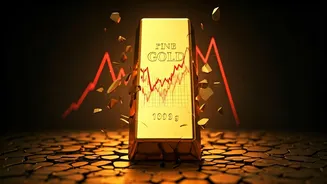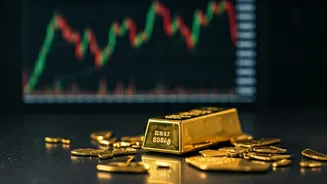The Precipitous Fall
The gold market witnessed a significant downturn, as gold prices plummeted, resulting in the most substantial single-day decline since 2013. The prices fell
dramatically, and the impact of the downturn was noticeable as silver prices also dipped. The decline was substantial, with gold rates falling to $4,000, and this decline marked a notable shift in the market trend. This drop in prices caught the attention of investors worldwide, generating concerns about the market's stability. Various analysts were busy examining the causes and possible effects of this notable market shift, with the biggest fall in gold prices in 12 years.
Causes and Drivers
Several factors are recognized as key drivers of the recent gold price crash. The primary contributor to the drop appears to be a strengthening of the US dollar, making gold more costly for holders of other currencies. Concurrently, increased expectations of interest rate hikes by the Federal Reserve have dampened demand for non-yielding assets, like gold. Additionally, market sentiment plays a critical role. If confidence in the economy improves, investors may shift away from gold, which is often considered a safe-haven asset during times of uncertainty. Speculative trading, driven by algorithms and quick decision-making, also exacerbated the decline, contributing to its rapid pace. Finally, technical factors, such as key support levels being broken, triggered further selling pressure, worsening the downward trend. All these factors combined led to the sharp fall.
Investor Implications
The sudden fall in gold prices had significant implications for investors. Those who held gold as an investment experienced losses, particularly if they did not have hedges in place. It prompted many to reassess their investment strategies and risk tolerance. The crash also presented opportunities for some investors. Traders with a long-term view might have seen the price drop as a chance to purchase gold at a lower cost, betting on a future price recovery. However, this required careful market analysis and an understanding of the risks. Moreover, the drop in gold prices also influenced the performance of gold-related stocks, which also witnessed declines, thereby affecting investor portfolios dependent on these assets. Overall, the gold price drop led to significant portfolio adjustments.
Market Forecasts
Predicting the future course of gold prices is inherently complex, given the multitude of impacting factors. Analysts have offered varied perspectives on the potential trajectory of gold prices in the short term. Some experts speculate that the price might continue to decline further, especially if the US dollar remains robust or if interest rates rise. Others propose that the drop might be a temporary correction, followed by a price rebound. These experts cite factors, like sustained geopolitical uncertainties and rising inflation fears, which could support gold prices. The market’s reaction will depend on numerous variables, including shifts in investor sentiment, economic data releases, and global events. Therefore, investors are keenly observing these factors to gauge the future path of gold prices.













